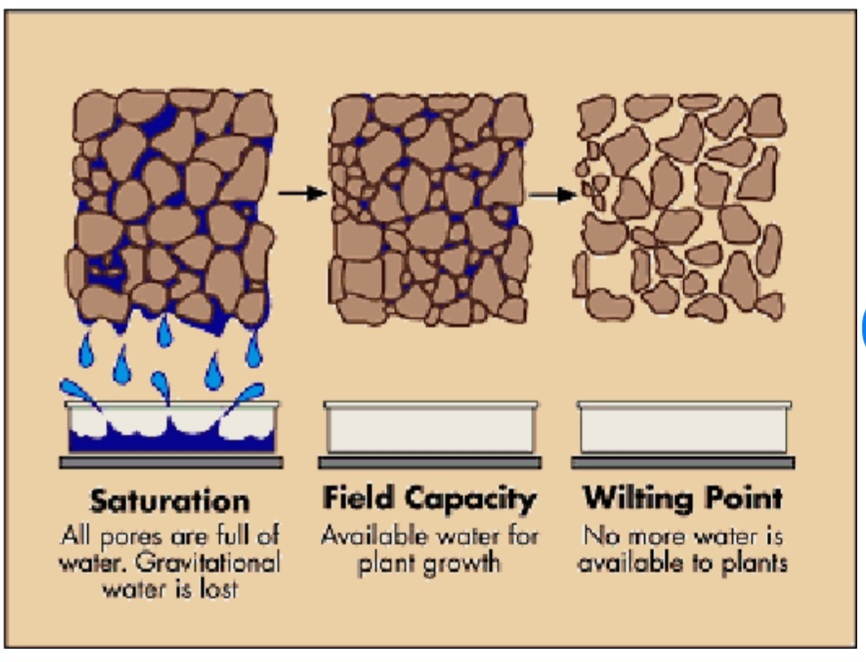
Soils vary in many different ways. They differ in texture, consistency, colour, infiltration rates, tilth, permeability, depth, organic matter content, and water holding capacity – to name a few. Soil moisture which is an important component of the soil is required by plant to survive while growing on the soil. This soil moisture are found within the micropores in the soil.
Not all soil moisture in a soil is available to plant. Some are lost through evaporation and transpiration, runoff, as well as drainage and infiltration .
Available water is retained in the soil after the excess has drained (field capacity to wilting point). This water is the most important for crop or forage production. Plants can use approximately 50 percent of it without exhibiting stress, but if less than 50 percent is available, drought stress can result. Unavailable water is soil moisture that is held so tightly by the soil that it cannot be extracted by the plant. Water remains in the soil even below plants’ wilting point .
Soil moisture is essential in making management decisions such as; types of crops to plant, plant populations, irrigation scheduling, and the amount of fertilizer to apply. All these depend on the amount of moisture that is available to the crop throughout the growing season.
Soils have ability to hold water in a process called soil water holding capacity.
Water Holding Capacity is the amount of water that a medium can hold. This is affected by the media composition, texture, plant roots, any rocks or similar and, in the case of pots, slabs or bags, the size and shape of the container.
Soil water holding capacity is used to optimize crop production and It is defined as the amount of water that a given soil can hold for crop use.
Field capacity is the point where the soil water holding capacity has reached its maximum for the entire field.
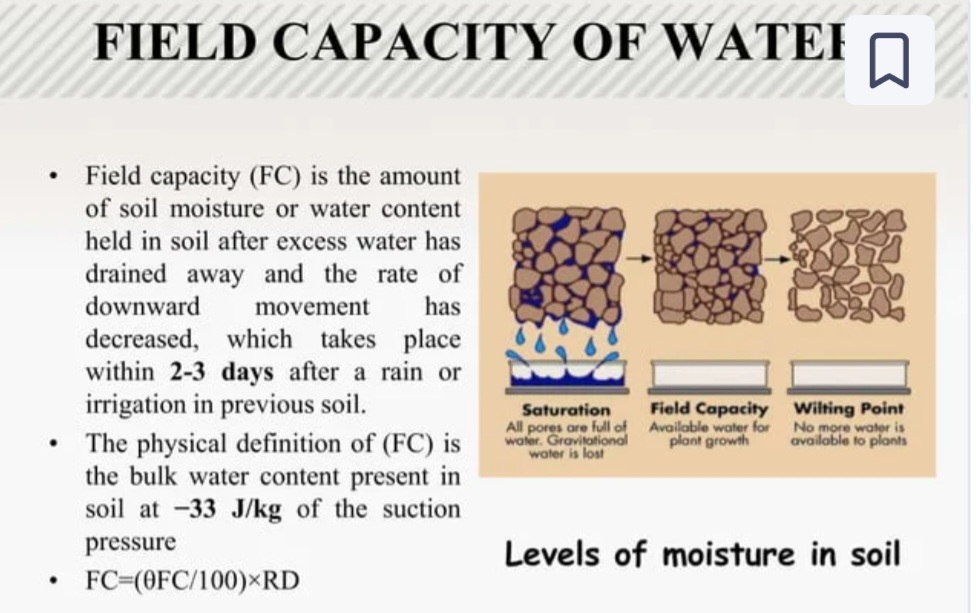
The goal of soil water holding capacity for agricultural producers is to maintain the field moisture at or near capacity.
IMPORTANCE OF SOIL WATER HOLDING CAPACITY
1. Soil moisture holding capacity is important because it helps plants grow.
2. It reduces the risk of flooding and erosion, and makes soil more resilient to extreme weather.
3. Soil that can hold more water can compensate for dry years when there isn’t enough precipitation.
4. Adequate soil moisture helps plants transpire efficiently, which cools the plant and transports nutrients.
5. Soils with a higher water holding capacity can store more water during wet periods, which reduces the risk of flooding and erosion.
6. Soils with a higher water holding capacity can resist extreme weather events like long, wet winters and hot, dry summers.
7. Soils with a higher water holding capacity need less water from rainfall or irrigation, which reduces the cost of irrigation.
8. It is used to determine how much water storage capacity the field has,
9. It is used to determine how much supplemental irrigation should be applied.
10. The WHC also determines how much irrigation water can be applied at one time to match the infiltration rate and avoid applying more water .
11. Maintaining soil water holding capacity can mean increased profits to farms.
12. It gives useful information about crop selection.
13. It gives information about ground water contamination consideration
14. It is used to estimate run off
Before further discussion about water holding capacity of soils, certain concept of capillarity needs to be understood.
1. CAPILLARITY: Water molecules behave in two ways:
a. COHESION FORCE: cohesion forces makes water molecules attracted to one another. Cohesion causes water molecules to stick to one another and form water droplets. While
b. ADHESION FORCE: Adhension force is responsible for the attraction between water and solid surfaces. For example, a drop of water can stick to a glass surface as the result of adhesion. It is adhension force that cling water to soil particles.
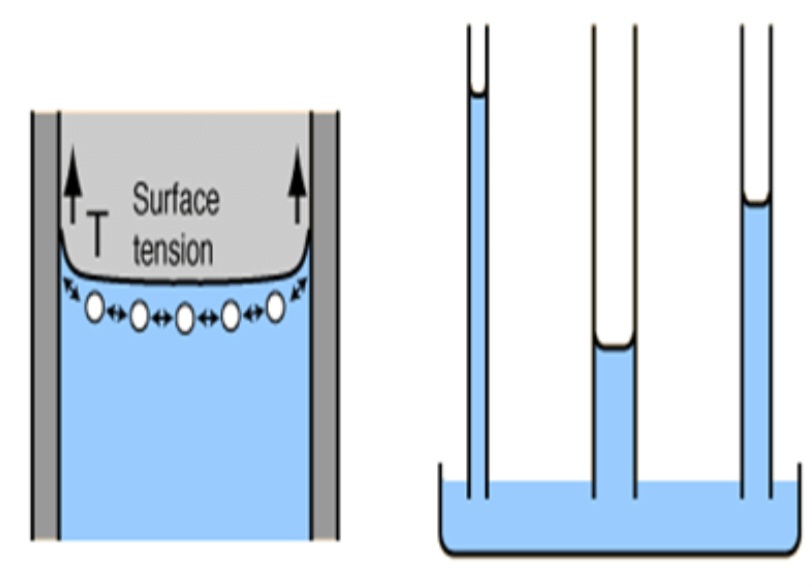
2. SURFACE TENSION: Water also exhibits a property of surface tension. Water surfaces behave in an unusual way because of cohesion. Since water molecules are more attracted to other water molecules as opposed to air particles, water surfaces behave like expandable films. This phenomenon is what makes it possible for certain insects to walk along water surfaces.
3. CAPILLARY ACTION: Capillary action, also referred to as capillary motion or capillarity, is a combination of cohesion/adhesion and surface tension forces. Capillary action is usually demonstrated in the laboratory using measuring cylinders or tubes of different width/sizes placed in a water bath to test the upward movement of water through the cylinders or tubes against the force of gravity. (Note that capillary action occurs when the adhesive intermolecular forces between a liquid, such as water, and the solid surface of the cylinder or tube are stronger than the cohesive intermolecular forces between water molecules.)
From the result of capillarity, a concave meniscus (or curved, U-shaped surface) forms where the liquid is in contact with a vertical surface of the cylinder or tube.
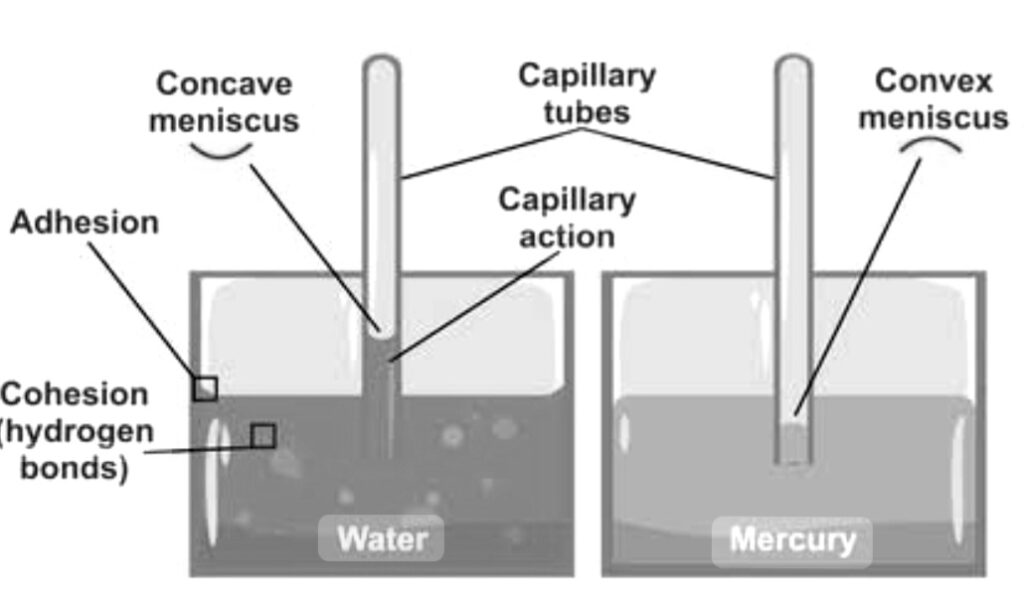
Capillary rise is the height to which the water rises within the cylinder or tube, and decreases as the width of the cylinder or tube increases. Thus, the narrower the tube, the greater the rise of water to a higher height. Meaning that the liquid rises to the greatest height in the narrowest tube whereas capillary rise is lowest in the widest tube. Also, this demonstration can also be related to what happens in the soil. Capillary action also occurs in soils. Smaller pores that exist in finely-textured soils have a greater capacity to hold and retain water than coarser soils. Water moves upwards through soil pores, or the spaces between soil particles.
The height to which the water rises is dependent upon pore size. As a result, the smaller the soil pores, the higher the capillary rise. Finely-textured soils typically have smaller pores than coarsely-textured soils. Therefore, finely-textured soils have a greater ability to hold and retain water in the soil in the inter-particle spaces which are called micropores. This exist in clayey or silty soils. In contrast, the larger pore spacing between larger particles, such as sand, are called macropores.
In addition to water retention, capillarity in soil also enables the upward and horizontal movement of water within the soil profile, as opposed to downward movement caused by gravity. This upward and horizontal movement occurs when lower soil layers have more moisture than the upper soil layers and is important because it may be absorbed by roots. As a result, finer-textured soils have greater water holding capacity than coarse textures soil
Therefore, it can be stated that capillarity is the primary force that enables the soil to retain water, as well as to regulate its movement.
FACTORS INFLUENCEING SOIL WATER-HOLDING CAPACITY
Water-holding capacity is controlled primarily by soil texture and organic matter. Soils with smaller particles (silt and clay) have a larger surface area than those with larger sand particles, and a large surface area allows a soil to hold more water. In other words, a soil with a high percentage of silt and clay particles, which describes fine soil, has a higher water-holding capacity.
SOIL TEXTURE: Soils are made up of three main components: sand, silt and clay. The proportion of each component determines the soil texture. Each soil texture has its own Water Holding Capacity (WHC). Water Holding Capacity in relation to soil texture is the ability of a certain soil texture to physically hold water against the force of gravity. It does this by soil particles holding water molecules by the force of cohesion. As an example, a sandier soil has much less water holding capacity than a silt loam soil. Due to the size of the soil particles, the cohesive properties are much different between a sand particle and a clay or silt particle.
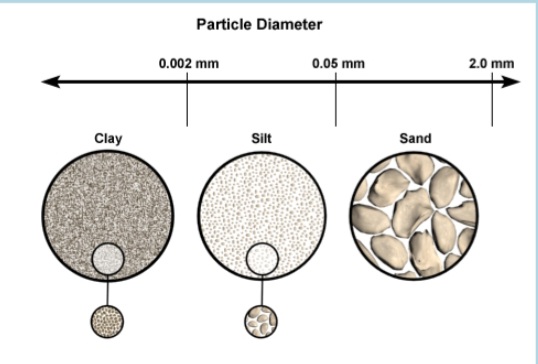
Clay particles have the ability to physically and chemically “hold” water molecules to the particle more tightly than sands or silts. Sands “give up” the water between the pores much easier than silts or clays.
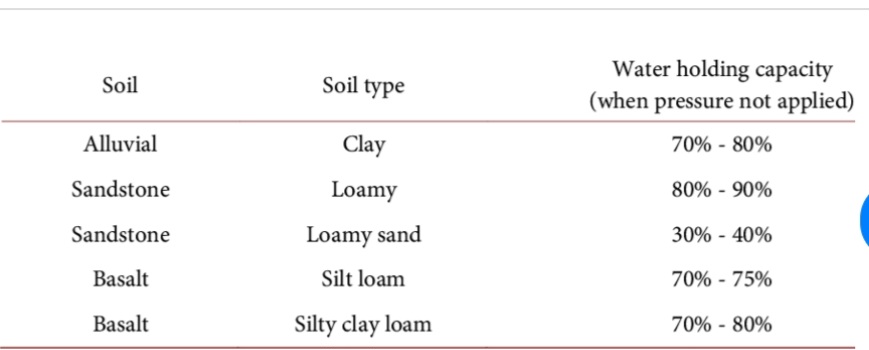
SOIL ORGANIC MATTER
Soil organic matter (SOM) is another factor that can help increase water holding capacity. Soil organic matter has a natural magnetism to water that is, organic matter has affinity for water. If the farmer increases the percentage of soil organic matter on his farm, the soil water holding capacity will increase. SOM is decayed material that originated from a living organism. SOM can be increased by adding plant or animal material.
HOW TO INCREASE THE SOIL WATER HOLDING CAPACITY ON FARMS
Changing the soil texture of the field is not a viable opinion to emback upon by farmers. Soil texture can be changed naturally by erosion, but that usually changes soil texture in a negative way. The best option for a farmer is to increase the soil organic matter of the soil.
Some basic ways to increase SOM include:
- Use cover crops
- Change to conservation tillage practices, for example no-till or minimal tillage
- Add manure
- Add compost
- Living crop residues on the farm after harvest
.WATER HOLDING CAPACITY OF VARIOUS SOIL TEXTURES
Sand = 0.8”/ft
Loamy Sand = 1.2”/ft
Clay = 1.35”/ft
Silty Clay = 1.6”/ft
Fine Sandy Loam = 1.9”/ft
Silt Loam = 2.4”/ft
In conclusion, the Maximum Water Holding Capacity, also known as the Field or Pot Capacity, is the maximum amount of water that specific pot/bag/slab/similar can hold without it draining out
